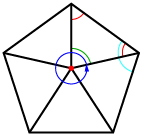Lesson 3
Completion requirements
Created by IMSreader
1. Lesson 3
1.5. Explore
Module 5: Geometry
Explore
In Try This 1, you may have noticed the following properties of regular polygons.
- All sides are equal.
- All interior angles are equal.
- If there is an even number of sides, then the opposite sides are parallel.
- If there is an odd number of sides, then there are no parallel sides.
- The number of lines of symmetry is equal to the number of sides.
Self-Check 1
![]()
- Answer “Build Your Skills” question 1 on page 207 of the textbook. Answer
So far you have looked at some of the properties of regular polygons. In the next Try This, you will take a closer look at the measure of the interior angles of regular polygons and how these angles can be determined.
Try This 2
Open Regular Polygons and use the Size slider to change the size of each regular polygon.
- If the lengths of the sides of a regular polygon change, do the interior angles change? Explain.
Use the following information and the image to answer the remaining questions.
Each interior angle of a regular pentagon is 108°. You will discover how this measurement can be calculated using triangle properties.

- From the centre of the pentagon, draw line segments to each vertex, similar to the diagram shown. How many triangles are formed? Are the triangles identical? Why or why not?
- At the centre of the pentagon, the triangles meet. What is the angle indicated in dark blue at the centre of the pentagon?

- Using your answers from questions 2 and 3, what is the measure of the angle of each triangle where it touches the centre of the pentagon (indicated in green)?
- What type of triangles are formed inside the regular pentagon?
- Using your answers from questions 4 and 5, what are the measures of the angles inside the triangle, indicated in red at the outer edges of the triangle?
- What is the measure of each interior angle of the pentagon (indicated in light blue)?
- What is the sum of the interior angles of the pentagon?
![]() Save your responses in your course folder.
Save your responses in your course folder.
This angle is one full rotation of a circle.

